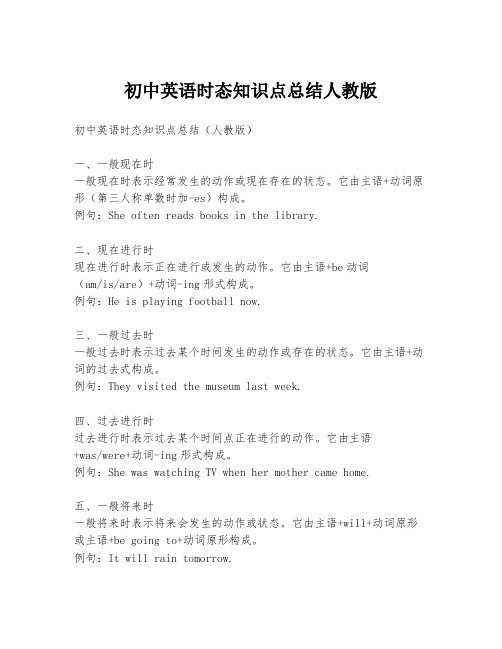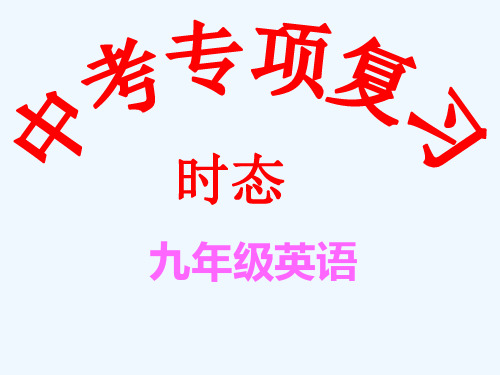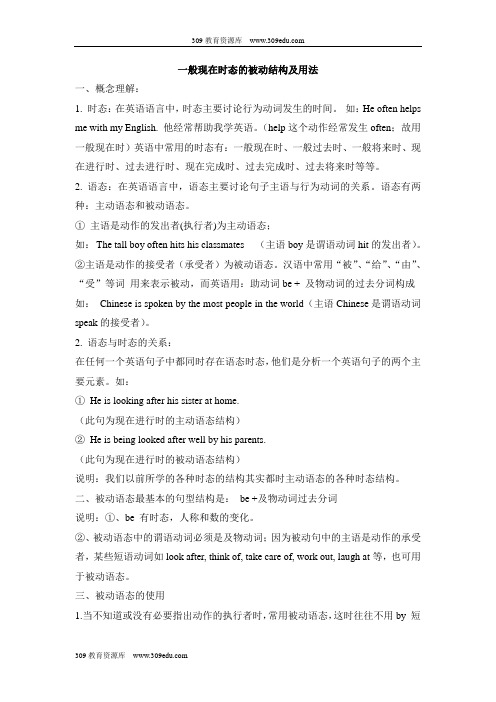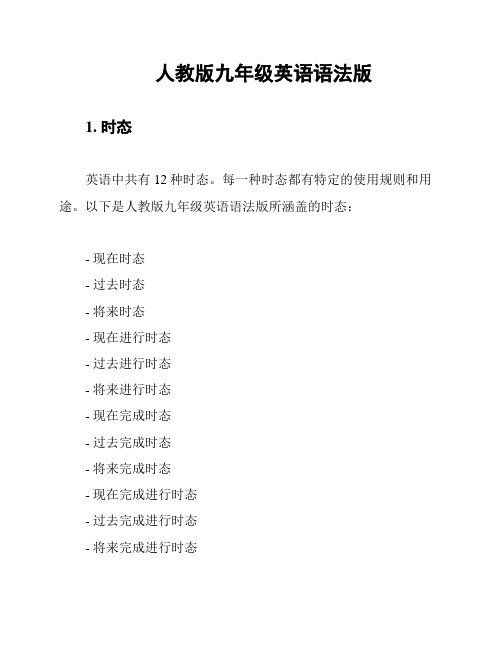英语人教版九年级全册时态讲解
初中英语时态知识点总结人教版

初中英语时态知识点总结人教版初中英语时态知识点总结(人教版)一、一般现在时一般现在时表示经常发生的动作或现在存在的状态。
它由主语+动词原形(第三人称单数时加-es)构成。
例句:She often reads books in the library.二、现在进行时现在进行时表示正在进行或发生的动作。
它由主语+be动词(am/is/are)+动词-ing形式构成。
例句:He is playing football now.三、一般过去时一般过去时表示过去某个时间发生的动作或存在的状态。
它由主语+动词的过去式构成。
例句:They visited the museum last week.四、过去进行时过去进行时表示过去某个时间点正在进行的动作。
它由主语+was/were+动词-ing形式构成。
例句:She was watching TV when her mother came home.五、一般将来时一般将来时表示将来会发生的动作或状态。
它由主语+will+动词原形或主语+be going to+动词原形构成。
例句:It will rain tomorrow.六、将来进行时将来进行时表示将来某个时间点正在进行的动作。
它由主语+will be+动词-ing形式构成。
例句:He will be working at this time tomorrow.七、现在完成时现在完成时表示过去发生的动作对现在造成的影响或结果,或者是从过去开始一直持续到现在的动作。
它由主语+have/has+动词的过去分词构成。
例句:I have finished my homework.八、现在完成进行时现在完成进行时表示从过去某一时间开始,一直持续到现在并可能继续下去的动作。
它由主语+have/has been+动词-ing形式构成。
例句:She has been studying English for five years.九、过去完成时过去完成时表示在过去某个时间点之前已经完成的动作。
英语人教版九年级全册初中常见时态总结思维导图式

初中英语时态复习巩固般现在时 (概念,句式结构, 常用时间状语; 用法)1、概念, 句式结构, 常用时间状语。
(1)概念: 一般现在是主要表示 经常性或习惯性 的动作或存在的状态, 也可表示 现在的情况或状态以及 永恒的真理 。
2)句式结构:Be (is , am , are ) + 表语,如: She is a beautiful girl.There be (is , are )句型,如: There is a schoolbag on the desk.实义动词作谓语 , 谓语用动词原形,但主语是第三人称单数时,谓语要用相应的单 数第三人称形式 如: They usually go to school on foot.She likes chocolate.3)常用时间状语: always , usually , often , everyday 等。
2. 一般现在时的用法( 1) 表示 经常性或习惯性 的动作或存在的状态,常与表频度的时间状语连用。
如:My mother often does housework. 我妈妈经常做家务。
(2) 描述现在的情况,状态等。
如:He speaks Russian very well. 他讲俄语讲得很好。
(3) 描述 客观真理、客观存在或科学事实 等。
如:Light travels faster than sound. 光比声音传播速度快。
( 4) 注:在含 时间状语从句或条件状语从句 的复合句中, 若主句用一般将来时, 则从句 用一般现在时表示将来,即“ 主将从现 ”如:I will ring you if he comes back tomorrow. 如果他明天回来,我就给你打电话。
例: I will send you an e-mail as soon as I ____________ in Canada.A. arrive B arrived C am arriving D will arrive(5) 在以 here , there 开头的句子中常用一般现在时代替进行时。
英语人教版九年级全册动词时态(教学设计)

动词时态(教学设计)一、教学内容六种动词时态二、教学目标(一)复习六种时态的定义,构成规则(二)能正确的运用动词的三种时态三、重点难点(一)初中英语动词六种时态的定义、规则(二)初中英语动词六种时态的用法四、教学过程(一)动词的时态在英语中,由于谓语动词发生的时间不同,或表达不同时间存在的状态,谓语动词都要发生相应的变化,这些动词的形式就叫做动词的时态。
英语共有16种时态,现阶段学生已学习6种。
现以动词do为例,将这6种时态构成列表如下:①现在:一般现在时:①do ②does;现在进行时:am/is/are doing;现在完成时:has/have done②过去:一般过去时:did;过去进行时:was/were doing③将来:一般将来时:①am/is/are going to do ②will/shall do1.一般现在时:(1)构成:①动词原形②动词第三人称单数形式(2)形式:①be动词:肯定句:主语+am/is/are+表语(n./pron./adj.)eg:I am/I’m a student. You are/You’re a student. He is/He’s/She is/She’s a student.否定句:主语+am/is/are+not+表语(n./pron./adj.)eg:I am not/I’m not a student. You are not/You’re not/You aren’t a student.疑问句:Am/Is/Are+主语+表语(n./pron./adj.)eg:Am I a student? Are you a student? Is he/she a student? Is it an apple?②其它动词:肯定句:主语+动词原形/第三人称单数形式(+宾语)(+状语)eg:I/You/We/You/They study English every day.否定句:主语+don’t/doesn’t(第三人称单数)+动词原形(+宾语)(+状语)eg:I/You/We/You/They don’t study English every day.疑问句:Do/Does+主语+动词原形(+宾语)(+状语)eg:Do I/You/We/You/They study English every day?(3)用法:①表示经常发生的动作或现在存在的状态eg:I go to school every day except Sunday.除了星期日,我每天都上学。
人教版九年级英语(全册)重点语法知识点复习梳理

人教版九年级英语(全册)重点语法知识点复习梳理人教版九年级英语重点语法知识点复习梳理一.介词by的用法(Unit-1重点语法)1.意为“在……旁”,“靠近”。
Some are singing and dancing under a big tree. Some are drawing by the lake.有的在大树下唱歌跳舞。
有的在湖边画画儿。
2.意为“不迟于”,“到……时为止”。
Your son will be all right by supper time.你的儿子在晚饭前会好的。
How many English songs had you learned by the end of last term?到上个学期末你们已经学了多少首英语歌曲?3.表示方法、手段,可译作“靠”、“用”、“凭借”、“通过”、“乘坐”等。
The monkey was hanging from the tree by his tail and laughing.猴子用尾巴吊在树上哈哈大笑。
The boy’s father was so thankful that he taug ht Edison how to send messages byrailway telegraph.孩子的父亲是那末的感谢,因而他教爱迪生怎样经由过程铁路电报来转达息。
4.透露表现“逐个”,“逐批”的意思。
One by one they went past the table in the dark.他们一个一个得在黑暗中颠末这张桌子。
5.表示“根据”,“按照”的意思。
What time is it by your watch?你的表几点了?6.和take , hold等动词连用,说明接触身体的某一部分。
I took him by the hand.我拉住了他的手。
7.用于被动句中,表示行为主体,常译作“被”、“由”等。
English is spoken by many people.英语被许多人说。
人教版九年级英语时态

时态1.一般现在时V原/V三单2.一般过去时V过去式3.现在进行时am/is/are+V-ing4.过去进行时was/were+V-ing5.一般将来时will/shall+V原am/is/are+going to+V原6.现在完成时hav e/has+V过去分词一、一般现在时(一)用法:1.表示现在的状态He is ten.She is at home.2.表示经常的或习惯性的动作I go to school at6:00every day.3.表示主语具备的性格和能力She likes apples.They know English.4.在条件、让步、时间状语从句中常用一般现在时表将来W e will go for a picnic if it is fine tomorrow.I will call you as soon as I get to Beijing.5.以here,there开头的句子中常用一般现在时代替现在进行时Here comes the bus!(二)结构:be(am/is/are)V原/V三单(三)常与一般现在时连用的时间状语always总是usually通常o ften经常sometim es有时every day每天once a w eek每周一次on w eek ends在周末【选词填空】1.He o ften(go/goes/went)to school by bus.2.W e’ll go t o the park if it(won’t rain/didn’t rain/doesn’t rain)tomorrow.3.I usually(get/gets/got)up at6:00.二、一般过去时(一)用法:1.表示过去某个时间发生的动作或存在的状态He went to the park last week.2.在虚拟条件句中,表示与现在事实相反的情况If I were you,I would take a small present.(二)结构:was/were V过去式(三)常与一般过去时连用的时间状语yesterday昨天last w eek上周last year去年a moment ago刚才three days ago三天前just now刚才in the past在过去in1998在1998年【选词填空】1.Y esterday he(clean/cleans/cleaned)the room.2.They(go/went)to the park last night.3.He(invents/invented)the p hon e in1945.三、现在进行时(一)用法:1.表示现在(说话瞬间)正在进行的动作He is watching TV now.2.表示当前一段时间内的活动或现阶段正在进行的动作W e are working on a farm these days.(二)结构:am/is/are+V-ing(三)常与现在进行时连用的时间状语now现在at the moment现在at present现在注意:Look!/Listen!后一般用“现在进行时”Look!She is dancing.Listen!He is singing.【选词填空】1.He(reads/is reading/was reading)a book now.2.Listen!They(are talking/was talking).3.Look!T wo girls(dance/are dancing)there.四、过去进行时(一)用法:1.表示在过去某一时刻或某一阶段内正在发生的事情I was playing computer games at9:00last night.2.由when引导的一般过去时的时间状语,当主句的动作为延续性时,则常用过去进行时She was watching TV when I came in.(二)结构:was/were+V-ing(三)常与过去进行时连用的时间状语at this time yesterday昨天这个时候then那时at that time在那时this morning今天早上【选词填空】1.She(is/was)watching TV when I came in.2.They(are/were)singing when the UFO arrived.3.When the alien got out,the girl(is/was)shopping.练习检测【选词填空】1.--What are they doing?–They(are/were)playing tennis.2.–What does your sister like doing?--She(liked/like/likes)singing.3.Mr Green(talked/is talking)t o the manager now.4.Listen!Someone(is singing/are sing).5.I will go out if it(will be/is)sunny tomorrow.6.My mother(cook ed/was cooking)when I came in.st w eek I(go/went)to Beijing.8.He(buys/bought)a pen two days ago.9.What(are/were)you doing when the UFO landed.五、一般将来时(一)用法:1.―will+动词原形‖表示将要发生的动作或情况I will go t o school tomorrow.2.―be go ing to+动词原形‖表示打算进行某活动,或某种迹象表明很可能要发生的事Look at the dark clouds!It’s g oi ng to rain.(二)结构:will/shall+V原am/is/are+going to+V原(三)常与一般将来时连用的时间状语next w eek下周next year明年tomorrow明天in10years10年后in the future 在将来六、现在完成时(一)用法:1.表示从过去某一时刻开始一直延续到现在的状态或动作(常用于延续性动词)I have studied here for2years.2.表示过去已完成的动作,强调对现在的影响或结果(常用于短暂动词)I have finished my homework.(二)结构:hav e/has+V过去分词(三)常与一般现在时连用的时间状语so far到目前为止all day整天for+时间段since+句子/时间点already已经yet仍然just刚刚ever曾经never从不【区别】现在完成时与一般过去时现在完成时强调的是现在的情况一般过去时则和现在不发生联系He has lived here since1992.(现在还住这里)He lived here in1992.(不知现在是否住这里)【区别】hav e/has been去过某地(现已回来)hav e/has gone去了某地(现没回来)我去过长沙很多次。
英语人教版九年级全册初中时态

Thank you!
②be about to do 结构表示客观、马上就要发生的事,一般不与具体的时间 状语连用。
③be going to 结构表示必然或很可能发生的事情;be to do结构表示按职责、 义务和要求必须去做或即将发生的动作。
4.现在进行时
(1)概念:表示现在或现阶段正在发生或持续的动作。
(2)构成形式:am/is/are+动词的-ing 形式。 (3)与现在进行时连用的时间状语及提示语有:now,these days, right now, at present, at this moment, Look!, Listen!等。
(9)there be结构的一般将来时为there will be/there is going to be。
(10)will/shall, be about to do 与 be going to 的区别。
①一般将来时的基本结构为“will/shall+动词原形”,表示一个将要发生的动 作或状态。
1.一般现在时
概念:(1)表示经常性、习惯性的动作;
(2)表示现在的情况或状态;
(3)表示客观事实和普遍真理
构成形式:am/is/are或实义动词的原形(主语 是第三人称单数时,动词要用第三人称单数 形式)。
时间状语:always,often,usually, sometimes,once a week,every day等。
①表示有礼貌地询问对方是否愿意或表示客气的邀请或命令时。
②表示意愿时。
③表单纯性的将来,与人的主观愿望和判断无关时。 The sun will set at 7:30 this afternoon. 太阳会在下午7:30落下。
(7)当主句为一般将来时态时,在if,as soon as,until, when等引导的 状语从句中用一般现在时代替一般将来时。 (8)位移词的进行时表将来。
人教版九年级英语时态

时态1.一般现在时V原/ V三单2.一般过去时V过去式3.现在进行时am/ is/ are + V-ing4.过去进行时was/ were + V-ing5.一般将来时will/ shall + V原am/ is/ are +going to + V原6.现在完成时have/ has + V过去分词(一)用法:1.表示现在的状态He is ten. She is at home.2.表示经常的或习惯性的动作I go to school at 6:00 every day.3.表示主语具备的性格和能力She likes apples. They know English.4.在条件、让步、时间状语从句中常用一般现在时表将来We will go for a picnic if it is fine tomorrow.I will call you as soon as I get to Beijing.5.以here,there 开头的句子中常用一般现在时代替现在进行时Here comes the bus! (二)结构:be(am/ is/ are) V原/ V三单(三)常与一般现在时连用的时间状语always总是usually通常often经常sometimes有时every day每天once a week 每周一次on weekends在周末【选词填空】1.He often (go/ goes/ went) to school by bus.2.We’ll go to the park if it (won’t rain/ didn’t rain/ doesn’t rain) tomorrow.3.I usually(get/ gets/ got) up at 6:00.(一)用法:1. 表示过去某个时间发生的动作或存在的状态He went to the park last week.2. 在虚拟条件句中,表示与现在事实相反的情况If I were you, I would take a small present.(二)结构:was/ were V过去式(三)常与一般过去时连用的时间状语yesterday昨天last week上周last year去年a moment ago刚才three days ago三天前just now刚才in the past在过去in 1998在1998年【选词填空】1.Yesterday he(clean/ cleans/ cleaned) the room.2.They(go/ went) to the park last night.3.He(invents/ invented) the phone in 1945.(一)用法:1. 表示现在(说话瞬间)正在进行的动作He is watching TV now.2. 表示当前一段时间内的活动或现阶段正在进行的动作We are working on a farm these days.(二)结构:am/ is/ are + V-ing(三)常与现在进行时连用的时间状语now现在at the moment 现在at present现在注意:Look!/ Listen! 后一般用“现在进行时”Look! She is dancing. Listen! He is singing.【选词填空】1.He(reads/ is reading/ was reading)a book now.2.Listen! They(are talking/ was talking).3.Look! Two girls(dance/ are dancing)there.(一)用法:1. 表示在过去某一时刻或某一阶段内正在发生的事情I was playing computer games at 9:00 last night.2. 由when引导的一般过去时的时间状语,当主句的动作为延续性时,则常用过去进行时She was watching TV when I came in.(二)结构:was/ were + V-ing(三)常与过去进行时连用的时间状语at this time yesterday昨天这个时候then那时at that time在那时this morning今天早上【选词填空】1.She(is/ was) watching TV when I came in.2.They(are/ were)singing when the UFO arrived.3.When the alien got out, the girl (is/ was) shopping.练习检测【选词填空】1.--What are they doing? –They(are/ were) playing tennis.2.–What does your sister like doing?--She(liked/ like/ likes) singing.3. Mr Green (talked/ is talking) to the manager now.4. Listen! Someone (is singing/ are sing).5. I will go out if it (will be/ is) sunny tomorrow.6.My mother(cooked/ was cooking) when I came in.7. Last week I (go/ went) to Beijing.8. He(buys/ bought) a pen two days ago.9. What(are/ were)you doing when the UFO landed.(一)用法:1. “will + 动词原形”表示将要发生的动作或情况I will go to school tomorrow.2. “be going to + 动词原形”表示打算进行某活动,或某种迹象表明很可能要发生的事Look at the dark clouds! It’s going to rain.(二)结构: will/ shall + V原am/ is/ are +going to + V原(三)常与一般将来时连用的时间状语next week下周next year明年tomorrow明天in 10 years 10年后in the future 在将来(一)用法:1. 表示从过去某一时刻开始一直延续到现在的状态或动作(常用于延续性动词)I have studied here for 2 years.2. 表示过去已完成的动作,强调对现在的影响或结果(常用于短暂动词)I have finished my homework.(二)结构: have/ has + V过去分词(三)常与一般现在时连用的时间状语so far 到目前为止all day整天for +时间段since + 句子/ 时间点already已经yet仍然just刚刚ever曾经never从不【区别】现在完成时与一般过去时现在完成时强调的是现在的情况一般过去时则和现在不发生联系He has lived here since 1992.(现在还住这里)He lived here in 1992.(不知现在是否住这里)【区别】have/ has been 去过某地(现已回来)have/ has gone 去了某地(现没回来)我去过长沙很多次。
人教版九年级英语知识点总结

人教版九年级英语知识点总结人教版九年级英语知识点总结一、时态和语态1. 现在时态:一般现在时、现在进行时、现在完成时2. 过去时态:一般过去时、过去进行时、过去完成时3. 将来时态:一般将来时、将来进行时、将来完成时4. 语态:被动语态的构成和用法二、语法1. 名词:单数和复数形式、可数和不可数名词、所有格的用法2. 代词:人称代词、物主代词、指示代词、不定代词、反身代词、相互代词3. 形容词与副词:形容词的用法、比较级和最高级、形容词副词的用法及区别4. 动词:及物动词和不及物动词、动词的时态和语态、情态动词、动词短语、非谓语动词5. 介词:常用介词、介词短语6. 连词:并列连词、从属连词、选择连词7. 从句:名词性从句、定语从句、状语从句、宾语从句8. 并列句和复合句:并列句的连接方法、复合句的主从句连接方法9. 特殊疑问句:疑问词的用法、特殊疑问句的结构三、词汇1. 名词、代词、动词、形容词、副词、介词、连词、冠词等各类词汇的掌握和辨析2. 词义辨析和词组搭配:同义词、反义词、近义词、词组搭配四、语音和拼写1. 音标的发音和辨析:元音、辅音的发音规则和特殊情况2. 单词拼写:规则拼写和不规则拼写五、阅读技巧1. 阅读理解的技巧:概括大意、推理判断、细节理解、词义猜测、逻辑填空等2. 阅读文章的结构:段落主题句、意思段、连词和过渡词3. 阅读理解题的解题方法:找关键词、排除干扰项、全篇综合等六、写作技巧1. 写作的基本要求和结构:开头、主体、结尾2. 写作技巧:应用词汇和语法知识、运用逻辑、使用过渡词和连词、积累和运用词组搭配3. 作文写作的各种类型:记叙文、说明文、议论文、应用文七、听力技巧1. 听力题型:听对话回答问题、听独白回答问题、听对话补全对话、听句子选择相应图片等2. 听力技巧:抓关键词、注意听句子的重点、根据上下文理解、预测答案等技巧八、补充知识点1. 文化背景知识:英语国家的文化、习俗和传统节日等2. 常用谚语和习语:理解和运用常见的谚语和习语3. 高考命题和应试技巧:分析命题趋势、熟悉高考题型、解题技巧和方法等以上是人教版九年级英语知识点的总结,希望对你有所帮助。
英语人教版九年级全册英语八大时态

1. He __________ back a month ago. (come)2. My mother often tells me __________ in bed. (not read)3. I must take it back the day after tomorrow. You can only __________ it for 24 hours. (保存)4. Why have you kept me __________ here for so long a time? (wait)5. Please come to our meeting if you __________ free tomorrow. (be)6. She __________ to the Great Wall several times. (goes)7. In his letter, he said that he __________ us very much. (miss)8. The film __________ for nearly fifteen minutes when I got to the cinema. (be)9. He said he became __________ in physics. (interest)10. This film is worth __________. (see)11. He went to school instead of __________ home. (go)12. In the old days it was difficult for the poor to __________ a job. (找)13. It's cold outside, so you'd better __________ your coat. (穿上)14. He is hungry. Please give him something __________. (eat)15. Please don't waste time __________ TV every evening. You should word hard at English. (watch)16. We found the window __________. (break)17. You have dropped your pencil. __________. (拾起来)18. Mother often tells me __________ too late. (not come home)19. You had better __________ by bus, or you will be late. (go)20. I will __________ Li Ming the good news as soon as I see him. (告诉)21. Great changes __________ in our country since 1978. (take place)22. I __________ my daughter since last month. (hear from)23. It __________ me two days to write the article. (花费)24. Don't touch that __________ child. (sleep)25. Every time he tried to start the car, the wheels ________deep into the mud. (sink)26. When I got home, I found that my room __________ breaks into sand a lot of things __________. (steal)27. If I had arrived there earlier, I __________ him. (meet)28. I didn't remember __________ her the book before. (give)29. He called at every door, __________ people the exciting news. (tell)30. Yesterday Mary couldn't finish her homework, so she has to go on__________ itthis afternoon. (do)。
人教版英语九年级全册Unit5一般现在时态的被动结构及用法

一般现在时态的被动结构及用法一、概念理解:1. 时态:在英语语言中,时态主要讨论行为动词发生的时间。
如:He often helps me with my English. 他经常帮助我学英语。
(help这个动作经常发生often;故用一般现在时)英语中常用的时态有:一般现在时、一般过去时、一般将来时、现在进行时、过去进行时、现在完成时、过去完成时、过去将来时等等。
2. 语态:在英语语言中,语态主要讨论句子主语与行为动词的关系。
语态有两种:主动语态和被动语态。
①主语是动作的发出者(执行者)为主动语态;如:The tall boy often hits his classmates (主语boy是谓语动词hit的发出者)。
②主语是动作的接受者(承受者)为被动语态。
汉语中常用“被”、“给”、“由”、“受”等词用来表示被动,而英语用:助动词be + 及物动词的过去分词构成如:Chinese is spoken by the most people in the world(主语Chinese是谓语动词speak的接受者)。
2. 语态与时态的关系:在任何一个英语句子中都同时存在语态时态,他们是分析一个英语句子的两个主要元素。
如:①He is looking after his sister at home.(此句为现在进行时的主动语态结构)②He is being looked after well by his parents.(此句为现在进行时的被动语态结构)说明:我们以前所学的各种时态的结构其实都时主动语态的各种时态结构。
二、被动语态最基本的句型结构是:be +及物动词过去分词说明:①、be 有时态,人称和数的变化。
②、被动语态中的谓语动词必须是及物动词;因为被动句中的主语是动作的承受者,某些短语动词如look after, think of, take care of, work out, laugh at等,也可用于被动语态。
英语人教版九年级全册语法复习之时态

8. 7. – What has happened to the fish, Mary?
9. -- Mum, the chaat s__e_a_te_n_ (eat) the fish. Just now
the jcuamt _p_e_d__(jump) onto the table anadte_____(eat)
动词时态
初中阶段8种时态: 1.一般现在时 2.一般过去时 3.一般将来时 4.现在进行时 5.过去进行时 6.现在完成时 7.过去完成时 8.过去将来时
(1) 一般现在时:
1.表示经常反复发生的动作.
2. e.g. They often spend their holidays in
the south.
5. -- ___Is_ my son __w_o_r_k_in_g___ (work) hard this term?
6. -- Oh, yes, he _is__tr_y_i_n_g__(try) his best now.
7. 6. D__o_e_s__ the hatfi_t______ (fit) me well?
it up. lived
10.8. Sam ____( live) in the small town fhoarvfievegryoewanrs
during the war.
saw
11.9. It is ages since I last ____(see) you. You
___(grow) taller.
进行)的动作: 4. e.g. We are writing a paper these days.
一般现在时与现在进行时的区别
1.进行时强调动作正在进行,而现在时强调动作的
人教版九年级知识点总结动词时态与语态

人教版九年级知识点总结动词时态与语态动词时态与语态是英语学习中非常重要的一部分。
掌握动词时态和语态的正确用法,不仅可以帮助我们表达准确的时间和语气,还可以提高作文的表达能力。
下面,我来总结一下人教版九年级英语课程中的动词时态与语态的知识点。
一、一般现在时态(Simple Present Tense)一般现在时态表示经常性的动作或客观事实。
句子结构为“主语 + 动词原形”。
例句:1. I go to school by bus every day.(我每天坐公交车去学校。
)2. She likes playing basketball.(她喜欢打篮球。
)二、一般过去时态(Simple Past Tense)一般过去时态表示过去发生的动作或状态。
句子结构为“主语 + 动词过去式”。
例句:1. We visited the museum last week.(我们上周参观了博物馆。
)2. He studied English for three hours yesterday.(昨天他学了三个小时的英语。
)三、一般将来时态(Simple Future Tense)一般将来时态表示将来要发生的动作或希望、打算的事情。
常用助动词“will”或“be going to”来构成。
例句:1. We will have a picnic next Sunday.(下周日我们将去野餐。
)2. She is going to study abroad next year.(明年她将出国留学。
)四、现在进行时态(Present Continuous Tense)现在进行时态表示现在正在进行的动作。
句子结构为“主语 + be + 动词的现在分词”。
例句:1. They are watching a movie at the cinema now.(他们现在正在电影院看电影。
)2. I am studying for my English test.(我正在为英语考试学习。
人教版九年级英语语法版

人教版九年级英语语法版1. 时态英语中共有12种时态。
每一种时态都有特定的使用规则和用途。
以下是人教版九年级英语语法版所涵盖的时态:- 现在时态- 过去时态- 将来时态- 现在进行时态- 过去进行时态- 将来进行时态- 现在完成时态- 过去完成时态- 将来完成时态- 现在完成进行时态- 过去完成进行时态- 将来完成进行时态2. 语态语态表示动词的主语与动作的关系。
英语中有两个基本的语态形式:- 主动语态- 被动语态人教版九年级英语语法版将详细介绍这两种语态的用法和变换规则。
3. 句型英语中有多种常见的句型结构,如主谓结构、主系表结构、主+谓+宾结构等。
这些不同的句型结构对语言表达有重要影响。
在人教版九年级英语语法版中,我们将研究并熟练运用这些常见句型,以提高语言表达能力。
4. 修饰语修饰语是用来修饰名词或代词的词语,可以进一步说明或限定名词的意义。
在人教版九年级英语语法版中,我们将研究不同种类的修饰语,如形容词、副词、限定词等,并研究如何正确运用它们。
5. 从句从句是一个完整的句子结构,可以作为另一个句子的一部分。
人教版九年级英语语法版将介绍不同类型的从句,如定语从句、名词性从句、状语从句等,让学生掌握如何使用和转换从句。
6. 句子的结构和标点符号句子是语言表达的最小单位,正确的句子结构和标点符号使用是语言准确性和流畅性的关键。
人教版九年级英语语法版将教授基本的句子结构和常见的标点符号使用规则。
以上是人教版九年级英语语法版的主要内容概述。
通过学习这些语法知识,学生将能够更准确、流利地表达自己的想法,并提高英语语言的应用能力。
- 1、下载文档前请自行甄别文档内容的完整性,平台不提供额外的编辑、内容补充、找答案等附加服务。
- 2、"仅部分预览"的文档,不可在线预览部分如存在完整性等问题,可反馈申请退款(可完整预览的文档不适用该条件!)。
- 3、如文档侵犯您的权益,请联系客服反馈,我们会尽快为您处理(人工客服工作时间:9:00-18:30)。
1 一般现在时的用法
1) 经常性或习惯性的动作,常与表示频腮度的时间状语连用。
时间状语:every…, sometimes,at…, on Sunday
I leave home for school at 7 every morning.
2) 客观真理,客观存在,科学事实。
The earth moves around the sun.
Shanghai lies in the east of China.
3) 表示格言或警句中。
Pride goes before a fall. 骄者必败。
注意:此用法如果出现在宾语从句中,即使主句是过去时,从句谓语也要用一般现在时。
例:Columbus proved that the earth is round..
4) 现在时刻的状态、能力、性格、个性。
I don't want so much.
Ann Wang writes good English but does not speak well.
比较:Now I put the sugar in the cup.
I am doing my homework now.
第一句用一般现在时,用于操作演示或指导说明的示范性动作,表示言行的瞬间动作。
再如:Now watch me, I switch on the current and stand back. 第二句中的now是进行时的标志,表示正在进行的动作的客观状况,所以后句用一般现在时。
一般现在时表将来
1)下列动词:come, go, arrive, leave, start, begin,
return的一般现在时表将来。
这主要用来表示在时间
上已确定或安排好的事情。
The train leaves at six tomorrow morning.
When does the bus star? It stars in ten
minutes.
2)倒装句,表示动作正在进行,如:
Here comes the bus. = The bus is coming.
There goes the bell. = The bell is ringing.
3)在时间或条件句中。
When Bill comes (不是will come), ask him to wait for me.
I'll write to you as soon as I arrive there.
4)在动词hope, take care that, make sure that等后。
I hope they have a nice time next week.
Make sure that the windows are closed before you leave the room.
比较过去时与现在完成时
1)过去时表示过去某时发生的动作或单纯叙述过去的事情,强调动作;现在完成时为过去发生的,强调过去的事情对现在的影响,强调的是影响。
2)过去时常与具体的时间状语连用,而现在完成时通常与模糊的时间状语连用,或无时间状语。
一般过去时的时间状语:
yesterday, last week,…ago, in1980, in October, just now, 具体的时间状语
共同的时间状语:
this morning, tonight,this April, now, once,before, already, recently,lately
现在完成时的时间状语
for, since, so far, ever, never, just, yet,
till / until, up to now, in past years, always, 不确定的时间状语
3)现在完成时可表示持续到现在的动作或状态,动词一般是延续性的,如live, teach, learn, work, study, know.
过去时常用的非持续性动词有come, go, leave, start, die, finish, become, get married等。
举例:
I saw this film yesterday.
(强调看的动作发生过了。
)
I have seen this film.
(强调对现在的影响,电影的内容已经知道
了。
)
Why did you get up so early?
(强调起床的动作已发生过了。
)
Who hasn't handed in his paper?
(强调有卷子,可能为不公平竞争。
)
She has returned from Paris.
她已从巴黎回来了。
She returned yesterday.
她是昨天回来了。
He has been in the League for three years.
(在团内的状态可延续)
He has been a League member for three years.
(是团员的状态可持续)
He joined the League three years ago.
( 三年前入团,joined为短暂行为。
)
I have finished my homework now.
---Will somebody go and get Dr. White?
---He's already been sent for.
句子中如有过去时的时间副词(如 yesterday,
last, week, in 1960)时,不能使用现在完成时,要
用过去时。
(错)Tom has written a letter to his parents
last night.
(对)Tom wrote a letter to his parents last
night.
比较过去时与现在完成时
1)过去时表示过去某时发生的动作或单纯叙述过去的事情,强调动作;现在完成时为过去发生的,强调过去的事情对现在的影响,强调的是影响。
2)过去时常与具体的时间状语连用,而现在完成时通常与模糊的时间状语连用,或无时间状语。
一般过去时的时间状语:
yesterday, last week,…ago, in1980, in October, just now, 具体的时间状语
共同的时间状语:
this morning, tonight,this April, now, once,before, already, recently,lately
现在完成时的时间状语
for, since, so far, ever, never, just, yet, till / until, up to now, in past years, always,
不确定的时间状语
3)现在完成时可表示持续到现在的动作或状态,动词一般是延续性的,如live, teach, learn, work, study, know.
过去时常用的非持续性动词有come, go, leave, start, die, finish, become, get married等。
举例:
I saw this film yesterday.
(强调看的动作发生过了。
)
I have seen this film.
(强调对现在的影响,电影的内容已经知道了。
)
Why did you get up so early?
(强调起床的动作已发生过了。
)
Who hasn't handed in his paper?
(强调有卷子,可能为不公平竞争。
)
She has returned from Paris.
她已从巴黎回来了。
She returned yesterday.
她是昨天回来了。
He has been in the League for three years.
(在团内的状态可延续)
He has been a League member for three years.
(是团员的状态可持续)
He joined the League three years ago.
( 三年前入团,joined为短暂行为。
)
I have finished my homework now.
---Will somebody go and get Dr. White?
---He's already been sent for.
句子中如有过去时的时间副词(如 yesterday, last, week, in 1960)时,不能使用现在完成时,要用过去时。
(错)Tom has written a letter to his parents last night.
(对)Tom wrote a letter to his parents last night.。
